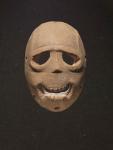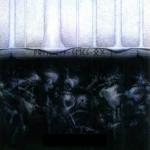A point about spoiler possibility. I share this because I've learned that my reading order of second and third books is reversed from usual, and therefore my perspective will be novel relative to some forum participants, therefore maybe mildly interesting to them.
My reading in
Deadhouse Gates has now progressed far enough (about 1/3 finished? ... the Apocalypse Dryjhna rebellion thing just started) that I have encountered several descriptions which might have been better experienced the other way around. I have heard about a few things in
Deadhouse Gates which seem to be written as though the author would have preferred that I heard about them there before having read their explanations in
Memories of Ice, rather than (as I am doing it) afterwards. It takes a bit to describe, because it's a missing emotion that I'm having. It's not just a plot issue; it's a question of lacking the full mysterious impact of certain revelations. The author's (seeming) intent, to make something seem eerie and ancient, may be a little tiny bit weaker on me than on someone who undertook the more common reading order.
These are parts in which (to-be-revealed-as Barghast?) centers of sorcery and gods are being re-discovered here and there-about the deserts of the Seven Cities continent. These locations come replete with cedar trees, boats, and magic. One was packed with shape-shifters and so forth. Well, I'm recognizing these locations as what
Memories of Ice reveals, rather late in that novel, as old old Warrens and sorcery centers created during, or descending from, the time before the Houses, when there were Holds, way back. The way they've been described in
Deadhouse Gates, there's a lot left out, and a reader unlike myself, who has not yet read
Memories of Ice, might really be intrigued by the growing mystery. The characters who find these locations in
Deadhouse Gates are on a quest to try to find them and to figure them out. In
Memories of Ice, the same locations were just outright explained to us (to us readers, and to some characters) by Barghast shamans and others who would have no problem recognizing these places. Erikson doesn't trickle in the details, slowly, chapter by chapter, as characters discover the things and are confused by them, in
Memories of Ice. There, he just outright dumps them onto us promptly, in service of other aims. The mystery of slow, confused progress isn't as necessary in
Memories of Ice, not like it is in
Deadhouse Gates.
It's not really a problem for me, in my experience of
Deadhouse Gates, to be able to go, in my head, "Aha, I think I know more about it than do Icarium and Mappo (or than does Sormo E'nath)". I don't mind, and it doesn't perturb my understanding of the plot or of the characters' motivations. But a little bit of the mystery is taken out. They're octagonal rooms with dugout canoes and cedar trees and they have a musty smell like a swampland. "Oh," my head goes, "Sounds like the original Barghast thingummy where Cafal explained in
Memories of Ice that his people originated on the sea but have lost contact with their elder Gods ...". I don't know yet, if I'm totally correct, and I don't mind if Erikson's story turns out to prove me wrong, that would be fine, I don't need to be "right" about it. But I do think I'm missing some of his intent of mystery and wonder, in the sense that my reader's eye is rather dismissive toward the whole swampy-rooms-in-the-desert mystery. Rather than getting piqued curiosity, I just jump to one of a number of reasonable links. Erikson seems in
Deadhouse Gates deliberately to have described these things, and plotted them out, to be vague, powerful, redolent of ancient and long-lost past. I don't get much of that effect through the course of reading
Deadhouse Gates. He wanted more mystery than I'm reading into them, and that lack is due to excess information which I gained in
Memories of Ice. The passage of whole aeons, the transition of a continental area from swamp to savanna to Sahara, the departure of the peoples once there, a sea-wide continental migration, canoe-borne wars, but WHO WERE THEY and what do they have to do with the rising power in the main
Deadhouse Gates plots? Erikson wants me to be intrigued and he leaves out necessary details; I'm rather more rational.
I've already seen this capable author explain past epochal shifts in ways that are related to changes in the Deck of Dragons, or in Houses, Holds, and Gods, and continental environmental changes. However, the mystery (of the octagonal rooms with cedar canoes) slowly being revealed in
Deadhouse Gates relies for its eerie, curiosity-piquing effect, at least partly, on readers not knowing that the scope of explanation can go so far back as to link together the wills of the Gods and rearrangements of the Decks, Houses, Holds. So it's less mysterious to me. Too bad. Only a mild disappointment, of course, and I'll enjoy whatever explanation comes about eventually (does it have something to do with how Otataral got deposited all over the nearest next peninsula?). But I'm not undergoing the ideal experiential sequence here.
Make sense? Sorry to blather on so much about it. Short version: the mystery and eeriness are gone, I'm not all goose-bump-y, because I know that the ultimate explanation will be on the continental and epochal scale, since I've seen explanations on that scale already, and since I've encountered (what look like) these things (swampy rooms with ancient magic and canoes) already.
This post has been edited by cliftonprince: 04 April 2016 - 12:46 AM

 Help
Help
















